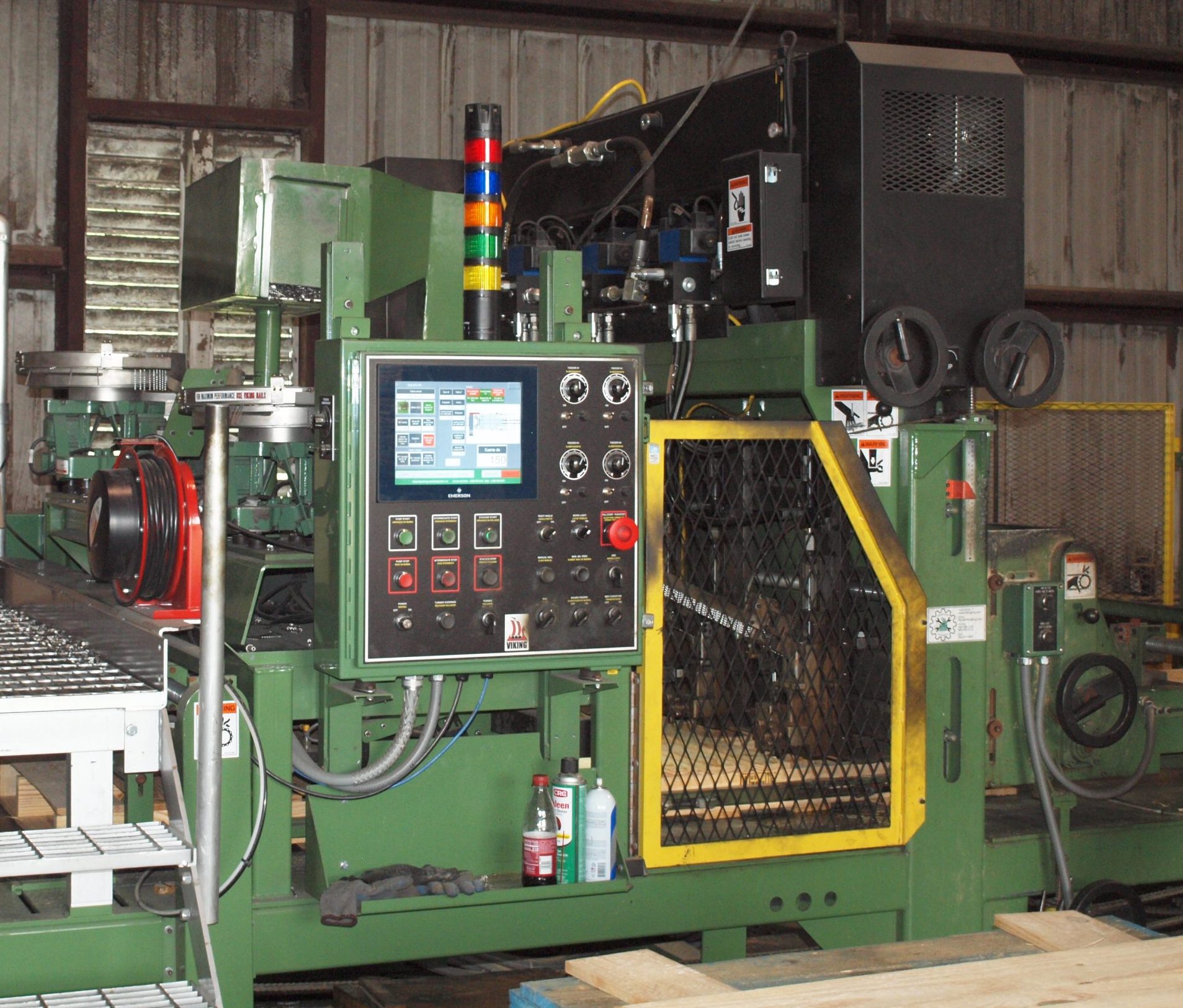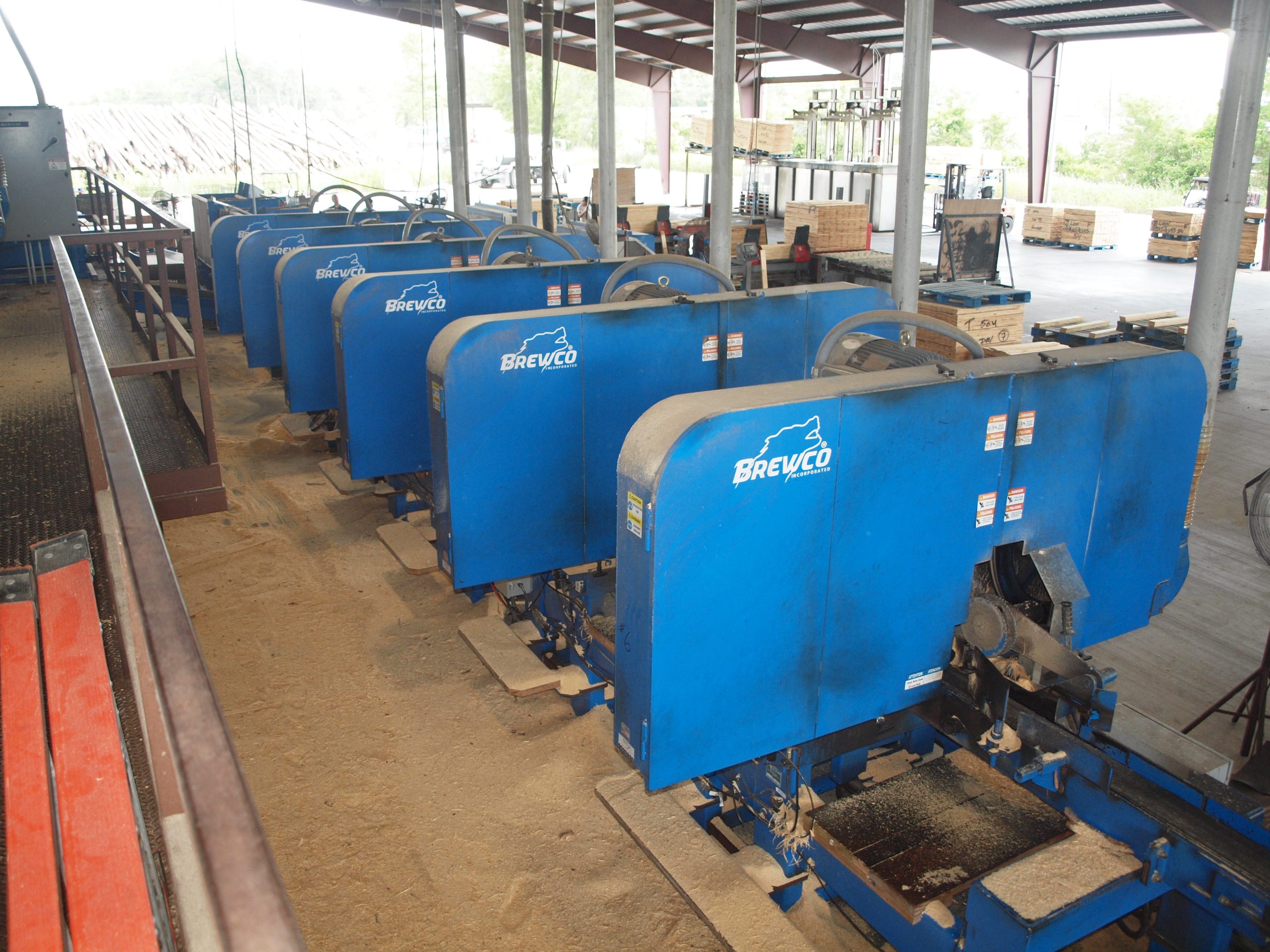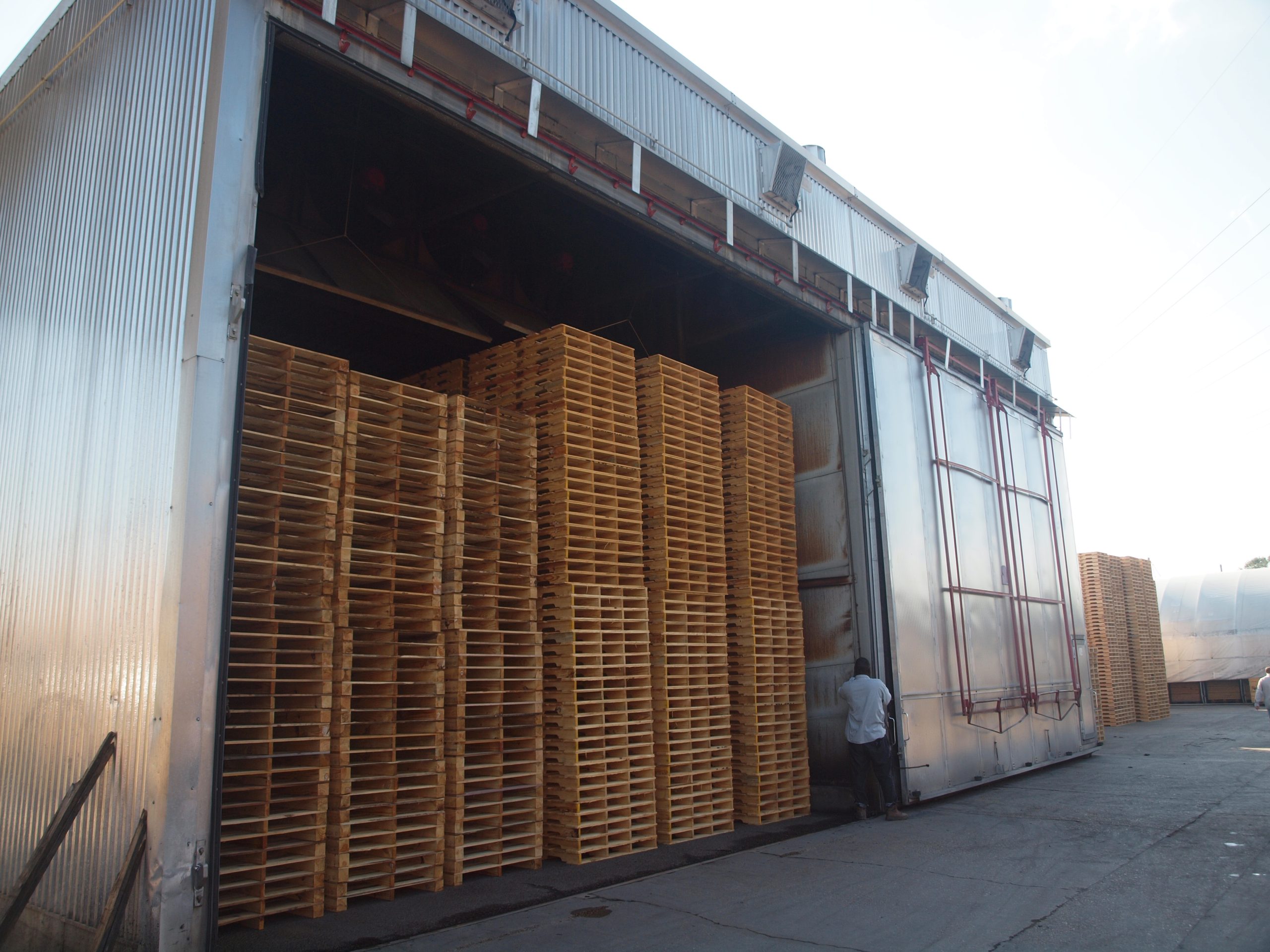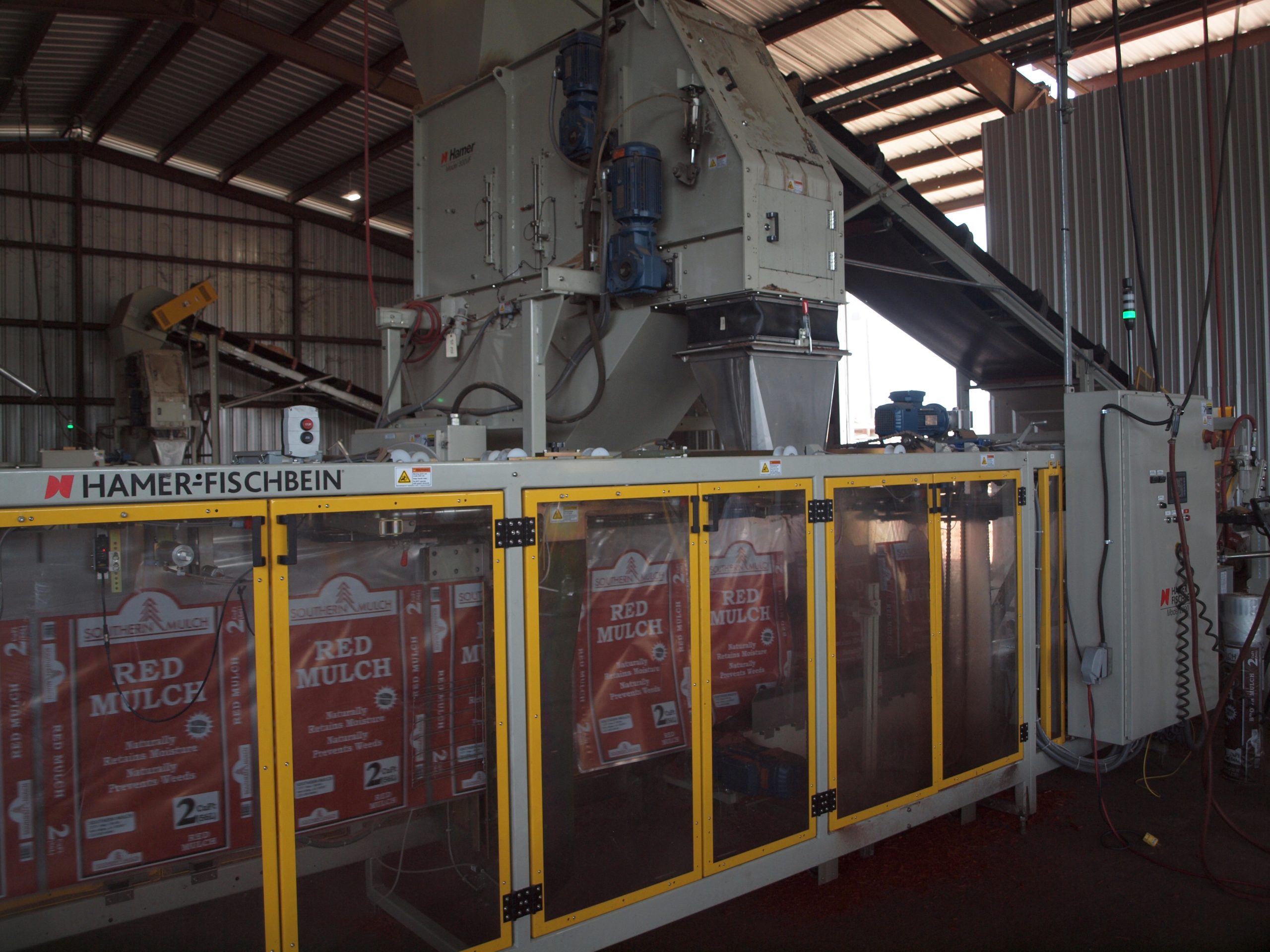Port Allen, LOUISIANA—Securing the future starts with innovation and continuous improvement for both Southern Packaging Inc. and
Viking Engineering & Development. With facilities in Port Allen, Louisiana, and Woodville, Mississippi, Southern Packaging continues to be a quality leader in new pallet production. Vertical integration and investment in automation enables the company to maximize profit while getting the most out of each log.
Brad Tuminello, the owner and president of Southern Packaging, admitted that his strategy is simple – just keep getting better and more efficient. He said, “We have used the profits created during the pandemic to reinvest in the company through automation to reduce staff and boost production while making operator jobs easier.”
During this automation phase, the company has added top equipment from Viking, Brewco, SII dry kilns and more. The company recently added a new Brewco line at its Port Allen facility and has a new 5-Stringer Viking Turbo 505 SE installing this December. By focusing on controlling every cut out of the log, Southern Packaging seeks to offer top-quality pallets at competitive pricing. Tuminello explained, “We’re a fully integrated operation from log to finished pallets. This includes five sawmills where we can process this material in a continuous flow or in batches for special sizes. This allows us to reduce waste and be very competitive on price with less volatility.”
Southern believes that top-quality timber leads to the best pallets. Tuminello said, “Everything that we cut goes into pallets, so our customers are not getting number three and number four grade pine on their pallets. They’re getting select number one, number two and number three to produce some of the highest quality pallets our customers can receive.”

Viking Turbos Are Workhorses for Southern Packaging
A key partner in this journey for Southern Packaging has been Viking Engineering. The company currently has ten nailing machines. Most are Viking Turbo 505s, seven at the headquarters location and three at the Mississippi plant.
Sean Sullivan, assembly operations supervisor commented, “We updated older nailing machines to streamline parts and maintenance processes. This means fewer parts to keep in stock.”
Sullivan explained why the company is sticking with the improved Turbo. He said, “Production is consistent, and the operating system on the new 505s is a lot more intuitive than the old control panels and the old systems. The new machines allow you to upload pallet designs using a laptop and remote access.”
In 2020, the company updated two older machines with Silver Edition Turbos. This version includes a cross-over catwalk for improved operator accessibility, an enhanced operator interface with quick-setting speed adjustments and increased conveyor motor ratio that has resulted in a 10-15% improvement in cycle time. Southern is getting an additional Turbo before year end with an optional fifth stringer capability. The Turbo 505 now also comes with 96″ stringer length configurations for producing oversized pallets.
Sullivan noted, “We really like some of the latest upgrades from a maintenance standpoint. The walkover catwalk is kind of nice to get over on the other side of the machine without having to walk all the way around the stacker. The hydraulics, motors and the pumps are all up top now. This makes them easily accessible for routine maintenance. We used to have to climb underneath the machine and really work to access them. Everything’s just a lot simpler. The pistons have gotten a little smaller on the nail driving so there’s more space in the area to work with.”
Tuminello added, “Viking has made the improvements for the people that have to run the machines and maintain the machines. Some manufacturers make good equipment, but they don’t take into consideration the operators and the maintenance staff who have to maintain the machines. Viking has made their equipment more user-friendly and maintenance-friendly.”
According to Southern Packaging, the new Turbos have increased production because the changeovers are faster and easier to dial in. Sullivan said, “There’s a lot more maneuverability that the 505s have. If I need to move a lead board just a little bit one way or the other or adjust a stringer position, it’s a lot simpler to do. There’s easy adjustments in there where you can fine tune the pallet when you’re setting it up, and then once it’s set up, you just keep running.”
Southern prides itself on being able to do any pallet size or design, the company specializes in custom pallets. This makes changeover speed a critical factor in meeting production targets. Depending on the number of changeovers, the company is able to get 2-3 truckloads done per shift per machine. Sullivan stated, “The Viking 505s are a workhorse for us. They are a steady machine. We don’t have to do a lot to them in terms of maintenance. You have some wear parts that need to be replaced, such as hoses and springs. All of our maintenance is done in-house.”
Between five sawmills, multiple Viking nailing machines, six kilns, two heat treatment chambers and over 40 forklifts, the company has built redundancy, ensuring that production remains humming. By having the same machines, it makes training and maintenance easier, as well as parts management.
Tuminello explained, “When we find a supplier that we like that supports their products well after the initial sale, we tend to stick with them.”
In addition to pallet manufacturing, the company also has recycling capabilities utilizing Smart Products equipment. While Southern Packaging is primarily a new pallet provider, it does offer recycling services to be a circular economy company and reduce waste.

New Brewco Sawmill Allows for Processing Larger Logs
Another recent investment by the company has been a new Brewco saw line designed to process large logs. The reason the company went with Brewco is that it bought a Big Jake scragg a while ago at its Woodville operation, and Southern Packaging has had good experience with the saw and decided to add another one in the Port Allen plant in 2018 and the newest addition in 2024.
Blaine Bergeron, plant manager, explained, “We have been very pleased with the performance of the Brewco mill that was installed in 2018. So, we decided to pull the trigger on another one. This system is more for making cants, stringers and longer logs versus short material that is processed through the scraggs. Currently, we run eight-foot up to 14-foot logs on the newest Brewco line.”
Southern Packaging cranked up the new Brewco line for the first time last week. It is replacing an older line. Tuminello suggested, “We are hoping for about triple the production than the old line with only a few more people required on the line.”
One of the biggest advantages of the mill is its ability to change over very quickly.
Bergeron, “We make changes to what we process fairly regularly on the Brewco line. We have options to cut deck boards or stringers. We’ll change sizes once, maybe twice a day, but the changeover time is very minimal on that mill.”
The new line is cutting 14-foot logs compared to 40- to 48- inch bolts on the older line. The new Brewco line is a long-log, sharp-chain sawmill.
A major factor in selecting equipment is the impact on workers. Tuminello explained, “Our goals are simple: invest money to automate, make jobs less physically challenging and by all means become the lowest cost producer. By that, I mean as much automation as we can invoke into the operation to outperform our competitors.”
Bergeron pointed out, “We’re planning on this mill to allow us to shut down two older antiquated mills.”
The process in this new mill starts with a front-end loader placing 12′ or 14′ precut logs onto the deck. Then, they go to a long log Brewco/Big Jake sharp chain scragg, where the double 52-inch head rig saws are cut to 7.5 or 11.25 inches. In creating a two sided block, the two sides fall onto a belt and go to a multi-trim saw to break down the longer pieces. Those pieces then go to two bull edgers, where an operator determines to get 1 or 2- 3.5″ pieces. These pieces then go to two finishing trim saws to get the precise length. The material is then transferred downstairs onto two Pendu dealer decks to singulate the material before going into a Brewco 4- head resaw. From there, the lumber goes through a Brewco deduster and is stacked by an AIT high-speed stacker.
Meanwhile, the two-sided log falls on its side after going through the first head rig and is transported to a second 48″ head rig, which clamps and automatically determines the width of the log and sets the blade to cut a pre-determined width to create a four-sided log. The side flitches are also recovered through the first multi-trim finishing line. The four-sided log then goes to a fixed Brewco 2- head splitter saw to get 2-3 cants. These cants exit the bandsaws and can either go outside to a Brewco cant sorting line to be stacked and used later or sent inside to a second multi-trim saw. From there, the cut-to-length blocks enter a Brewer gangsaw in order to cut stringers. These stringers are processed through a Brewer notcher and are stacked by another AIT high-speed stacker.

People Power – Longevity Helps Ensure Quality
Brad Tuminello knows that you don’t make any of the automation go well without the right people, and he has been fortunate to have a lot of his people stay around for a long time.
Tuminello admitted, “Tenure comes by taking care of your employees as best as you can. Sean Sullivan has been with us 21 years, and Blaine Bergeron has been with us 28 plus years. He is currently the plant manager and will be named the company president in the near future.”
Bergeron added, “We have also been fortunate to be able to reload key positions with younger talent. We recently hired four mid-20-year-old positions to assume some important roles, such as maintenance, operations, log procurement and mulch operations.” The company hires a lot from family members or people who are close to existing workers or management. For example, Blaine’s brother, Blake Bergeron, is the head millwright and has been with the company for 15 years.
A few people have recently retired. The company had an employee retire this year who has been with the company for 31.5 years. This employee, Fred Wilson, was 87 years old when he stopped working. Tuminello said, “We appreciate his longevity. And it shows if you take care of your people, they will stick around.”
Another long-term employee, Kaki Scott, retired after 22 years. Other long-time employees include: Kenny Saucier, 21 years, head of maintenance; Pam Bratcher, 14 years, head of human resources; Keith Powell, 25 years, forklift operator; Pat Toussant, 21 years, loading supervisor; John Latham, 12 years, assembly supervisor; and many other employees with over 10 years of experience.
Many of the employees are connected via family or friend relationships. Blaine Bergeron’s sister-in-law, Ruth Williams, is the office manager. Father and son Chris and Jared Chustz work together in maintenance. A number of members of the Tuminello family work in the business, including Brad Tuminello, owner; his son Harrison Tuminello; and Mike Tuminello, nephew who is the plant manager of the Woodville facility.
Other key personnel include: Freddy Cortez, Keith Lessard, and Amy Propes in the recycling department; Jacob Martin, Jackie Spiers, and David Bacon in the mulch operation. Many of the shop production workers are family members as well. Nine women work in the offices of Southern Packaging and Southern Mulch. They handle all the administrative functions from payroll to driver dispatching, billing, customer services, government reporting and more. The company recently hired a certified public accountant, Cole Bishop, to oversee the financial and business operations as Brad Tuminello slowly starts to semi-retire.
Brad’s son has come into the business and is training under Blaine Bergeron.

SII Dry Kilns Provide Tremendous HT Capacity
A high percentage of the pallets produced by Southern Packaging require heat treatment and/or kiln drying to meet customer needs and export requirements. As a result, having significant heat-treating capacity is a must. The company has two Bruner Hilderbrand units able to heat treat two truckloads each. The Port Allen plant uses four SII kilns, allowing for an eight-truckload capacity. The Woodville operation has one SII kiln, which will process two loads, and one Nyle dry kiln.
Tuminello joked, “We can cook some pallets…We’ve been very pleased with the SII kilns, and like Viking, if we’re pleased with it and our staff gets to know it, and the service after the sale is there, we tend to stick with the same manufacturers.”
Bergeron explained, “We saw the need to kiln dry pallets, so we added SII kilns, which gives us the capability of doing KD pine or heat-treating pallets. I can put whatever I want in there and get it knocked out.”
Turning a Waste Stream into Usable Products
Downfall residuals from the plants get used so that there is no waste. The Port Allen location turns sawdust, pine bark, shavings into soil and mulch products.
Bergeron explained, “All the material from the Brewco sawmill (2018 expansion) goes through a 300-hp Stringer Hog to produce mulch. The sawdust is sold off to either a paper mill or a pellet production plant. Other waste streams are sold to our sister company, Southern Mulch, to produce mulch and soil products.”
The bark is ground in a CBI grinder and is put into a special machine to create the company’s unique blend of soil products. Jacob Martin, biomass processing supervisor, stated, “We have a special formula that we use to blend the ground up bark with manure and a byproduct from the sugarcane industry to produce soil. This process is all done by us on site, and we regularly test the soil to ensure the proper consistency and ph levels.”
Mulch and soil products are sold off in bulk and bags. The company uses two Hamer automatic baggers with robots to bag and stack all the material coming off the line.
Tuminello admitted, “The ability to get rid of your residuals is getting harder and harder by the day. And once you reach a point where you can’t get rid of your residuals, you better buy land, or you’re going to choke and suffocate.”
He added, “We have worked hard to find alternative markets for residuals because the amount of material taken by paper mills is a quarter or less than what it used to be.”

Expansion and Automation Efforts
The addition of high-quality equipment like the Brewco sawmill and Viking Turbo 505 nailing machines has been instrumental in streamlining production and simplifying maintenance, allowing Southern Packaging to meet customer demands with greater speed and precision. “We want to extend our heartfelt thanks to Southern Packaging for their continued trust and partnership,” said Viking President Kurt Larsen. “For nearly 30 years the Turbo 505 has delivered consistent, high quality pallet production. Its unmatched performance, versatility and durability have helped hundreds of businesses, like Southern Packaging, reach the Next Level.”
Tuminello declared, “We have been able to achieve our payback goals from all of the equipment we have bought. We are usually looking for an ROI somewhere in the 3-5 year range.” From continuous improvement to vertical integration to adding newer, younger personnel, Southern Packaging is positioning itself to be quality and cost competitive well into the future.
Innovation and Growth at the Core of Viking’s Future

Viking Engineering & Development continues to push the boundaries of innovation in the pallet machinery industry. “This year has been exciting, we’ve celebrated key milestones, introduced significant software updates, and expanded our team,” said Kurt Larsen, president of Viking Engineering. “I am incredibly proud of the Viking team and all we have accomplished. Viking’s success is built on the dedication of our people who consistently reach for the Next Level and push us to deliver the best machinery in the industry. The Turbo 505 stands as a proven leader, the workhorse of the industry. With decades of consistent performance, the 505 has set the standard for quality and durability, I’m proud to see it continue to fuel our customers’ growth around the world.”
Looking to the future, Larsen added, “As we move forward, our focus is clear: to continue refining our machines and developing industry-leading technologies that enable our customers to succeed in an increasingly competitive market. One example is that we are currently vetting partners to help us with board and stringer loading the Turbo and Voyager machines.”
Voyager: A Bright Future
Voyager has reached a major milestone with over 20 machines installed across five countries. “Customers love the increased speed, dual board hoppers and quicker changeovers; but for some, the machine was stopping too much,” commented Larsen. “We have been chipping away at the cause of the stops. Set up is key, and additional training here has helped.”
In response to customer feedback, earlier this year Viking launched the Gen 2 software update, that introduced auto and rapid recovery features. These new features allow Voyager to detect errors in the nailing process and automatically recover from the issue, while providing operator prompts on how to improve the mechanical setup of the machine to prevent the error from occurring. Additionally, the Gen 2 software provided Spanish-language settings and pictograms to make it easier to use for Viking’s customers who have diverse workforces.
Finally, Viking recently finished validating improved sensors for the Voyager. “Some customers noted they were occasionally experiencing stoppages due to using darker grades of lumber or wet lumber,” explained Larsen. “We are updating the sensors on Voyager machines to enable our customers to run a wider variety of raw materials, including darker lumber grades.”
Voyager’s cutting-edge technology, including servo motors and torque feedback controls, allow for the monitoring of the pallet through the entire assembly process, paving the way for incorporation of future technologies and automation. For those customers needing additional throughput or simply looking to operate at a new level, Voyager is a strong platform, with some of the best features yet to come.
Smart Data: Maximizing Machine Performance
Viking is pushing forward with Smart Data, a system designed to monitor machine performance and provide real-time production data to operators. The next phase of this technology will provide even more detailed error reporting, as well as introduce machine diagnostics and preventative maintenance alerts to enable customers to maximize their uptime and production rates.
“Viking is committed to ensuring that our machines deliver maximum performance and reliability for years. Part of that is empowering our customers with the tools to maintain machine health and keep production running smoothly,” said Kurt Larsen. “Viking equipment has the best ROI in the industry because we design our equipment with longevity, ease of maintenance and operational excellence in mind.”
Staff Development: Investing in People
Viking continues with its strong focus on people. Recently two industry veterans came aboard to strengthen the sales team and assist with Viking’s focus on expansion in Latin American countries. “We are thrilled to continue building strong partnerships in the Latin American market, where we see tremendous growth opportunities. We look forward to helping more businesses reach the NEXT LEVEL with Viking’s equipment,” acknowledged Larsen. This year Viking installed two new machines in Mexico, a 96″ Champion QC306 and a Turbo 505 SE.
Internally, as part of its continuous improvement process, Viking, has been implementing Lean manufacturing to improve its supply chain and vendor reliability, increase its capacity, reduce its production lead times, and continue driving quality improvements. World renowned Lean expert, Guy Jones, held trainings for the entire organization.
“Viking remains committed to providing the highest quality, the most innovative solutions, and the best service and support in the pallet industry,” said Larsen. “Our team is growing, our technology is advancing, we are constantly investing to improve our products and our operations, and we are excited for what the future holds.






